Menu
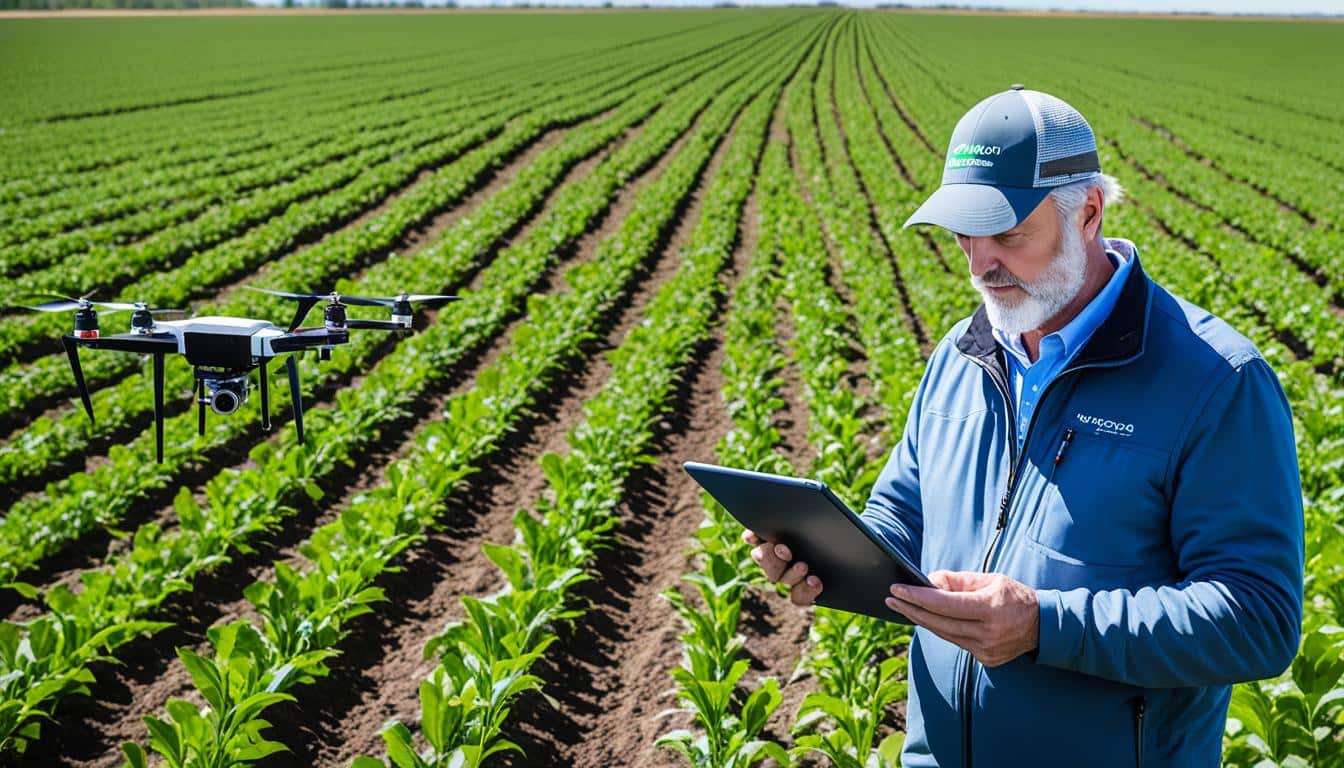
“The science of today is the technology of tomorrow.” – Edward Teller.
Edward Teller’s words are more relevant than ever, especially in agriculture and machine learning. With the world’s population set to hit 9.7 billion by 2050, farming must produce more. To meet this demand, we need to use technology, like machine learning, in farming. This will help us deal with issues like less land, not enough workers, and the effects of climate change.
The global market for agriculture’s biologicals could hit $25 billion by 2027. This shows a larger interest in sustainable farming. Yet, many farmers worry about how well these products work. Machine learning offers a way out by finding new helpful microbial strains. This can make biopesticides, biofertilisers, and biostimulants work better, increasing trust in these solutions.
Intellias is a leading company with over 20 years in the agricultural field. They have shown how AI and machine learning can change the game in farming. Their work has improved checking quality, tracking products, and following rules. In a world where we must do more with less land, AI in farming brings hope for better and more efficient practices.
Machine learning is changing how we farm. It brings new tools like crop monitoring and machines that can work by themselves. This tech uses lots of data to make farming better and help farmers make smarter choices.
AI in farming covers a wide range of projects. For example, it finds diseases in fish farms quickly and ensures Italian tomatoes are really from Italy. A system for choosing fish feed, based on seeing and using special light, is one example. This shows how smart tech can improve farming. Also, it proves the origin of rice using several factors. This highlights how AI can help in many ways in farming.
For the U.S., tech that sees and learns provides detailed info about farming across the country. This tech offers endless possibilities for using AI in agriculture.
Using AI in farming is key to facing many challenges. It helps make sure we have enough food sustainably. Tech like precision farming is really good at using data to save water and resources.
These advances show the huge impact AI can have in farming. They help us keep up with the growing need for food in a world that’s always changing.
| Application | Technology Used |
|---|---|
| Pathogen Detection in Salmon Farming | Machine Learning |
| Feeding Decision Systems in Aquaculture | Computer Vision, Neuro-fuzzy Model, Near-Infrared Technology |
| Authenticating Italian Tomato Products | Multi-element Approach |
| Authenticating Rice | Multivariate Data Analysis |
| Spatial and Temporal Coverage in U.S. Agriculture | Near-Infrared Technology, Deep Learning Neural Network |
By 2050, the world’s population will top 10 billion. Given this, AI tech in farming is more vital than ever. From 2023’s USD 1.7 billion, it is expected to soar to USD 4.7 billion by 2028. With AI, old-school farming methods are getting a fresh, smart twist, thanks to data analysis.
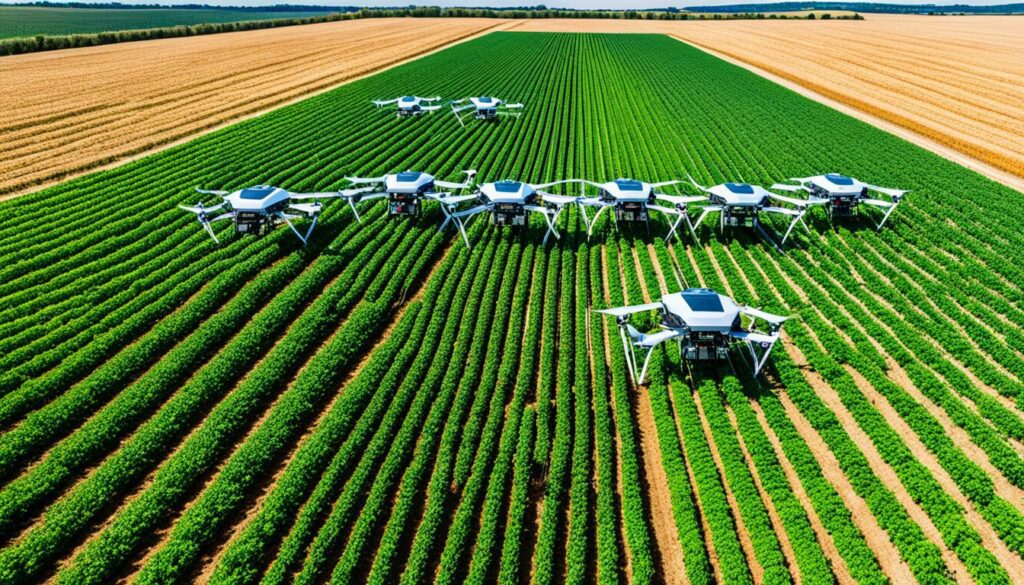
AI tools are key in studying farm data, making farmers’ lives easier. They gather and understand all sorts of info like crop details and weather. This allows AI to predict things like wheat growth and the ripeness of tomatoes accurately. It can also find plant diseases and insects nearly perfectly.
AI can run farms on its own, water crops precisely, and manage pests with AI drones.
| AI Technology | Application | Benefit |
|---|---|---|
| Drones | Precision Pesticide Application | High Accuracy Levels |
| Computer Vision | Image Recognition for Weed Detection | Efficient Crop Management |
| Natural Language Processing | Agriculture-specific Systems | Enhanced Decision Support |
AI helps farmers in a big way by making decisions smarter. It predicts market needs, tells the best times for planting, and suggests just the right amount of fertiliser and pesticide. This doesn’t just boost crop harvests but also cuts down on waste and ups profits. Through AI, planning crops and using resources better has become simpler.
On top of that, AI also aids in choosing when to water crops and in looking for the best farm strategies. AI systems learn from data over time, improving how they handle tasks. For instance, they can predict the future price of crops. Real-time data is at the heart of AI making farming more precise. For example, companies use AI to check how food and living conditions affect the health of cattle, showing just how much AI can do to change farming for the better.
In today’s farming, using top-notch data is vital. Artificial Intelligence (AI) helps gather detailed agricultural data. This allows farmers to look closely at things like tracking their supply chain and boosting crop yields. Thanks to predictive analytics, farm businesses can manage big data efficiently. This leads to better farm outcomes by marrying top-notch soil care with smart data use.
Gathering farming data includes using machine learning to observe lots of crop and environmental details. The mix of AI and machine learning in farming is vast, shown through many real cases. These cases, like the work of Devinder Kaur and Shanmugavadivu Pichai, really get into how to watch crops, predict the weather, and manage soil well. All this helps farmers decide more wisely.
Predictive analytics are changing the game for farm businesses. Imagine using advanced methods to spot apple diseases early or to better classify farms. This approach doesn’t only look at saving costs from using less fungicide but also measures many farming aspects to find real ways to act. The outcome is a smart farming method that makes sure farm tasks are done right, saving money and making farms more profitable. These modern farming solutions, mainly based on machine learning, give farmers useful tips to prevent pests and keep the soil healthy.
| Application Area | Methodology | Results |
|---|---|---|
| Apple Leaf Disease Detection | Deep Learning | 89% Accuracy |
| Farm Classification | Naive Bayes, SVM | Improved Decision-Making |
| Early Disease Detection | PLSR Analysis | High Accuracy with R2 = 0.74, 0.71 |
The rise of precision agriculture solutions marks a new start in farm management. This approach focuses on making best use of resources with the help of AI. It changes how we use water and farm chemicals wisely. These changes help farms work better and fight big environmental issues.
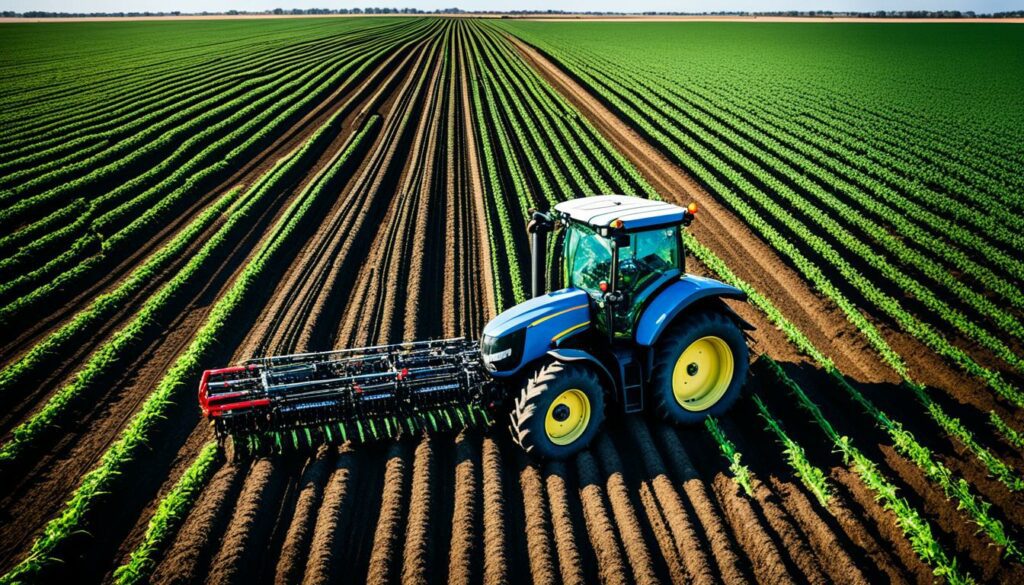
One big plus of precision agriculture is smarter use of resources. AI helps keep an eye on water and chemical use, stopping waste. For example, with vertical farming, smart tech manages water so plants get just enough. It’s part of a growing trend where machine learning in farming is set to hit an important value by 2027.
Precision farming also cuts down on harm to the environment. Using AI, farmers can be careful with where they use pesticides and fertilisers. This way, they lower the risk of harming the land or water. An example is from the University of California, Davis, where using smart tech improved grape production while using less water.
These smart practices help farming be kinder to the planet. By using resources better, precision farming helps meet green goals. The market for these smart solutions is expected to grow a lot by 2027. It shows a strong move towards more sustainable farming.
The world’s population is growing and is likely to hit 10 billion by 2050. To feed everyone, we need to make farming more effective. AI tools are leading this charge. They can outperform humans by delivering precise and efficient results.
Automated farm machinery, like driverless tractors and robotic harvesters, is changing farming. These machines are efficient and save money. They can check what the market needs and when is best to plant or harvest crops. This boosts farm productivity.
These machines also make fewer mistakes than people do. This cuts down on wasted time and resources.
AI drones and imaging are key in smart farming. They can spot crop issues, like apple black rot, with great accuracy. They also know what insects are around, helping reduce the need for a lot of pesticides.
AI drones are much better at applying pesticides than people. This saves resources and is better for the environment.
AI drones also play a big part in collecting and analysing farm data. This is crucial for planning and knowing how to take care of soil and crops. They can find leaks in irrigation systems too. This makes farming use water better and helps save resources.
These advanced machines and drones are making farming better. They use resources smarter and are helping agriculture be more profitable and eco-friendly.
Using IoT in agriculture brings big changes. It makes farming more detailed and quick to react. All thanks to sensors and precise farming, we expect the market to be worth $13 billion by 2026. This tech helps make smarter choices, cuts costs, and boosts eco-friendly farming.
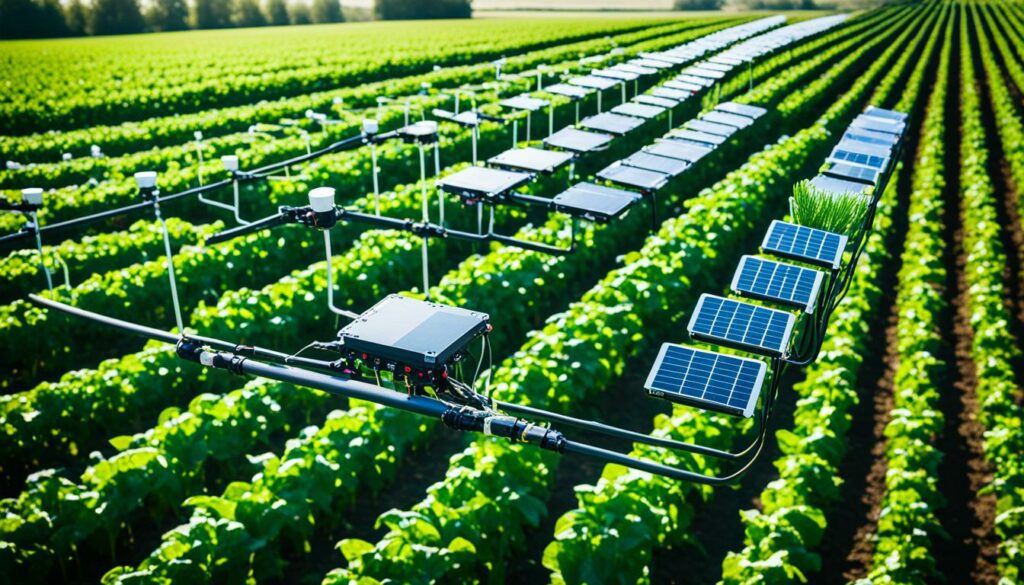
IoT soil sensors are a key part of high-tech farming. They give farmers up-to-the-minute data on soil health, temperature, and moisture. This data helps farmers make choices that make the farm more productive and uses resources better. This has made farms work better by fixing problems before they get serious.
Smart greenhouses are a great use of IoT in farming. These high-tech buildings use IoT to keep the perfect conditions for plants, like the right temperature and humidity. This helps plants grow better and uses resources wisely. The smart agriculture market, now worth about $4.6 billion, welcomes this new tech in greenhouses.
| Statistic | Value |
|---|---|
| Funding increase in agronomy sector | 80% over the past decade |
| Financial value of global smart agriculture market | $4.6 billion |
| CAGR of smart agriculture market | Just below 12% (2015-2020) |
| Projected valuation of global agricultural IoT market by 2026 | $13 billion |
| Growth in agriculture software adoption in US (by 2022) | Over 14% |
Spending in IoT for farming shows we believe in its big payoffs for efficiency and being eco-friendly. The step forward with soil sensors and smart greenhouses is vital. It aims to meet the greater need for food around the world.
Machine learning in agriculture is vital for boosting efficiency and productivity. It helps in forecasting crop yields and improving farming methods. This technology is transforming the way farmers work through predictive crop modelling and data organisation.
Predictive crop modelling uses algorithms to guess future yields. It considers weather, soil, and plant types. This helps farmers decide when to plant and harvest for better yields.
This technology can avoid a year of field tests in breeding. It allows farmers to make many personalised decisions each season. It helps choose the best seeds by predicting gene combinations that offer strong traits.
Good data management is key for making the most of machine learning. It helps collect and analyse big data sets. This gives farmers useful tips for their farming methods.
Farmers use tools like Climate FieldView™. This platform lets them spot diseases from field images and offers solutions. It’s good at finding diseases early by looking for patterns in images. This cuts down on mistakes and waste.
Integrating machine learning in farming is a big deal worldwide. The AI market in agriculture is set to jump from USD 2.08 billion in 2024 to USD 5.76 billion by 2029. This shows how important data and its careful use are for improving farming.
| Aspect | Current Value | Projected Growth | CAGR |
|---|---|---|---|
| Global AgTech Market | $24.08 billion | – | – |
| AI in Agriculture | $2.08 billion (2024) | $5.76 billion (2029) | 22.55% |
| IoT in Agriculture | – | $78.85 billion (2030) | 12.6% |
Machine learning changes agriculture as a powerful tool. It brings new ways like predictive crop modelling and data handling. With these, farming is on track for big steps forward.
AI in farming is changing how we grow crops by using smart ways to check soil nutrients and apply fertilisers accurately. This helps farms around the world produce more food, which is crucial as we look ahead to 2050.
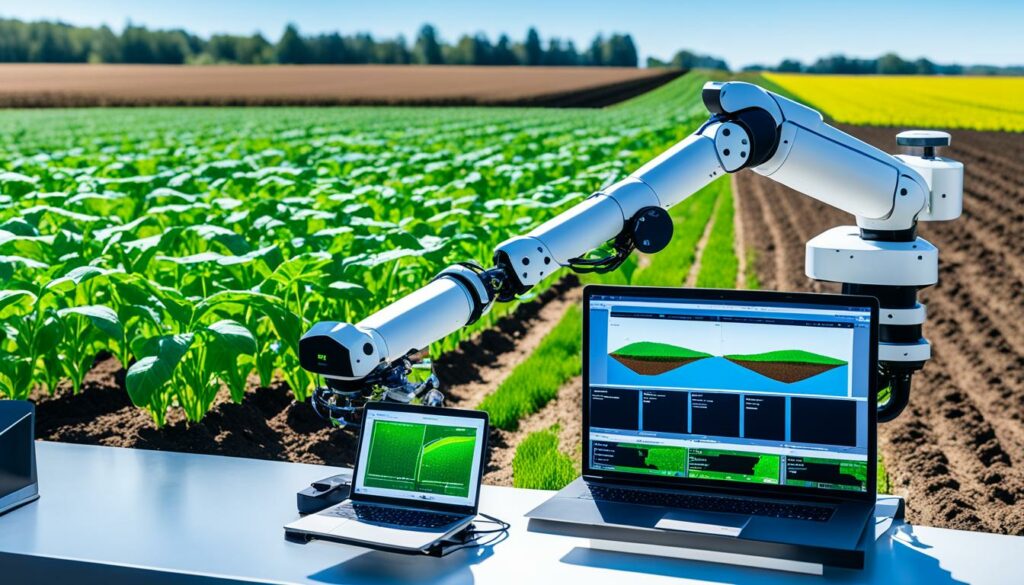
AI gives farmers a detailed look at the condition of their soil. It uses special algorithms to track things like rain, temperature, and how much stress the plants feel. By combining remote sensing and math models, we get better at understanding soil health. This has shown great promise in figuring out how well corn, wheat, and even strawberries will grow.
Another big win with AI in farms is using the right amount of fertiliser. Smart programs figure out exactly what each plant needs to grow well. They check things like the best time to plant and how green the plants look, advising farmers on the perfect fertiliser dose. This helps avoid using too many chemicals. For instance, in California, smart cameras caught plant problems early, cutting down on pesticide use and ramping up harvests by a third. In India, new companies are also using AI to predict weather and moisture, boosting crops by a lot.
The need for more food is pressing, with climate change and more people to feed. AI’s role in making farms more efficient is key. Experts think we need to grow 60% more food by 2050. AI can help us tackle this challenge, making sure farming stays strong for the future.
Automated irrigation systems have changed the way we manage water in farming. They use machine learning to control water. This means each plant gets just the right amount, cutting down on waste. AI in irrigation can save up to 25% of water, helping fight the global water crisis.
Smart water management is key in these systems. They use AI to set the right schedules for watering and avoid using too much water. By checking the weather and soil moisture, they make smart choices about when to water. This approach saves energy and money. AI can also fine-tune irrigation methods like sprinklers and drip systems for the best results.
These systems are great at spotting leaks and damage early. They keep an eye on the pipes all the time. By finding and fixing problems before they get big, they help save water and money. This means less work for farmers and fewer chemicals, which is good for the environment.
Using AI in smart irrigation systems does a lot more than just manage water. It boosts farm productivity by doing the watering automatically and spotting issues early. These new systems are a smart choice for today’s agriculture.
AI is changing how we deal with crop diseases. It lets us spot diseases quickly and act fast. This helps to save our crops from getting ruined. Let’s explore how AI uses special methods to fight off pests. This means farmers can deal with bugs effectively.
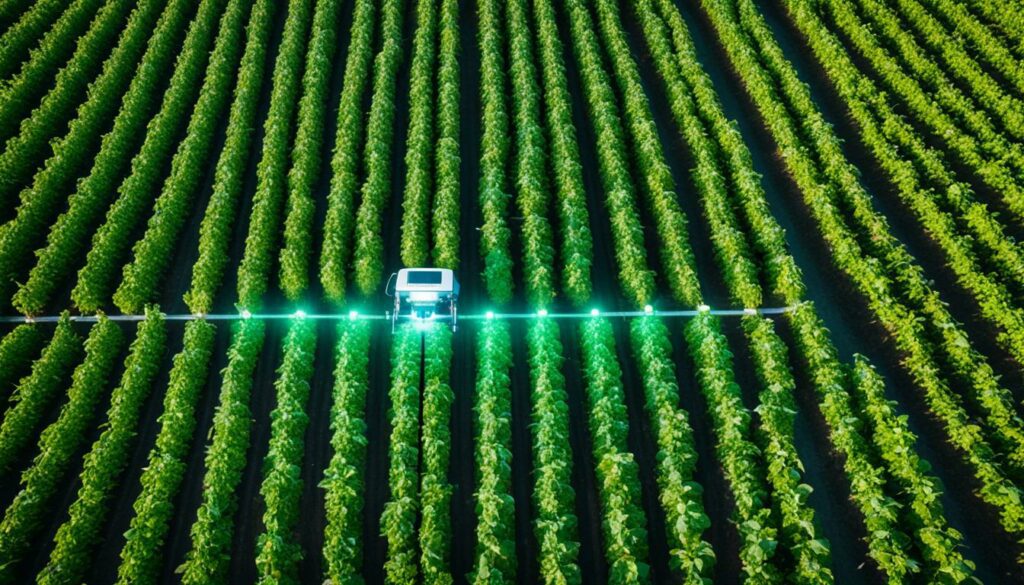
AI spots diseases by looking at crop images with machine vision. Deep learning (DL) is a big part of this and it’s really good at recognising things in pictures. It can quickly see if a crop is sick and what’s making it sick. By doing this, it helps farmers catch problems early.
Automated disease detection through ML and DL can deliver rapid, accurate results, ultimately enhancing crop quality and yield.
Fighting off pests is key to keeping our crops healthy. A lot of our crops are lost each year because of bugs and diseases. AI tools with good cameras and smart programs can find pests fast. This quick detection allows farmers to act right away.
| Method | Benefit | Application |
|---|---|---|
| Machine Vision | Accurate detection of pathogens | Disease identification |
| Deep Learning | Superior to conventional methods | Categorisation and severity estimation |
| High-Resolution Imaging | Enhanced clarity and precision | Pest identification |
AI is making farming better. It’s not just about spotting diseases quickly. It’s also about managing pests well. AI helps farmers from noticing small problems to suggesting the best solutions. With AI, agriculture is getting stronger, protecting our crops around the world.
Using artificial intelligence (AI) in farming is changing how we grow food. It helps farmers produce more while saving money. With the world’s population expected to hit 10 billion by 2050, farming needs to be smarter and more efficient.
AI uses smart machines like driverless tractors and advanced water systems. These tools do tasks better than people, like applying the right amount of pesticides. This means less waste and saves money.
AI can also check when wheat and tomatoes are ready quickly. It makes farming less reliant on workers, which saves on wages. This smart approach increases profits for farms.
AI is a game-changer in cutting costs on farms. It powers machinery that’s more accurate and works harder. For example, you have AI-powered drones. They decide how much pesticide to use, stopping overuse and pollution.
AI is also great at knowing when crops need attention. It acts fast and makes farming more efficient. This saves money on workers and time, helping farms make more profit.
AI not only helps buy less and sell more efficiently, but it also boosts farm earnings. AI joined with agriculture software manages when to plant, what to buy, and how to keep track of money. This makes farms operate better and make more money.
Thanks to AI, farms can make smarter choices with data about how well crops are growing and what affects them. This high-tech information means better crops and more profit.
AI also spots when there might be a disease in the plants. This means farms can act fast to prevent big losses. It’s all about making more money in a way that’s good for the environment.
“With the AI in agriculture market set to hit USD 4.7 billion by 2028, farming’s future is bright. It promises big savings and profits.”
AI farming is set to change how we grow food. It will help us feed the world in a smarter and greener way.
Modern farming has seen a great change with AI-based livestock health monitoring. Solutions like CattleEye use AI to improve how we track and analyse animal health. These systems help us get better yields, care for animals, and manage our farms more efficiently.
AI models are key in watching over livestock’s health. They can spot if animals are sick or hurt by looking at how they move. For example, Vision AI keeps an eye on how animals feed, drink, move, and behave. This early warning system helps find diseases and injuries quickly. It stops illnesses from spreading and makes animals’ lives better.
AI also looks at how much animals eat, spotting unusual eating habits fast. This keeps animals healthy and lets us act early to prevent sickness. AI can also look at how animals act to see if they are stressed or in pain. This helps us make choices that are good for the animals.
Thanks to drones with AI, we can check on livestock in big areas without trouble. This makes everything safer and more secure. Using these technologies helps us use our resources well, making farming more sustainable. With AI in farming, we are creating a future where smart tech and care for animals go hand in hand.
Machine learning in agriculture has many uses. It monitors crops and soil. It also operates farm machinery autonomously. The goal is to make farming processes and decisions better.
Farmers need AI to tackle big challenges. These include lack of land and workers, climate shifts, and poor soil. AI boosts quality control, tracking, and rules adherence. This makes our food system safer and sustainable.
AI and data analysis process big data for farming insights. They support choices that enhance farm efficiency and eco-friendliness. For example, they tell us the best times to sow and harvest. They also recommend the right fertilisers and pesticides.
Data-driven farming uses detailed data and forecasts. This improves crop yields and uses resources better. This approach boosts efficiency and production by enhancing supply chain and yield processes.
Precision agriculture uses AI to improve resource use, like water and chemicals. It does this through methods such as vertical farming. This lowers costs, helps the environment, and supports sustainable farming.
AI tools, like advanced farm machines and drones, make farming more precise. They better monitor and manage crops. This improves the way farms work, replacing old methods with more precise technology.
IoT shapes a farming system that responds in real-time. It tracks soil and manages greenhouses smartly. This setup optimises conditions for plant growth and resource use. It helps farmers make better decisions.
Predictive crop modelling predicts yields using machine learning. It looks at weather, soil, and crop data. This helps in planning and using resources smartly for the best crop production.
AI improves how we apply fertilisers to crops. It makes sure they get the right nutrients. This raises crop yields and lowers chemical use. It keeps the growing conditions perfect.
Automated irrigation with machine learning manages water use wisely. It decides the right water levels for plants using real-time data. It also spots leaks and damage, saving water and increasing its use.
AI spots diseases quickly by looking at images. This fast action helps control pests and manage diseases effectively. Thus, it keeps crops healthy.
AI makes farming more efficient, cuts down manual work, and uses resources better. This saves a lot of money and makes farming more profitable.
AI monitors and analyses the health and actions of farm animals. For example, CattleEye technology checks on cattle from afar. This boosts their health and productivity, leading to more resources like milk.